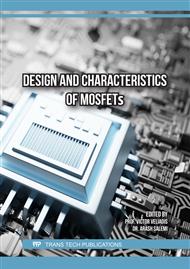[1]
Lim, J., et al., Enhanced Photon Utilization in Single Cavity Mode Air-Bridge Thermophotovoltaic Cells. ACS Energy Letters, 2023. 8: pp.2935-2939.
DOI: 10.1021/acsenergylett.3c00720
Google Scholar
[2]
Pribble, W., et al. Applications of SiC MESFETs and GaN HEMTs in power amplifier design. in 2002 IEEE MTT-S International Microwave Symposium Digest (Cat. No. 02CH37278). 2002. IEEE.
DOI: 10.1109/mwsym.2002.1012216
Google Scholar
[3]
Sabri, S., et al. New generation 6.5 kV SiC power MOSFET. in 2017 IEEE 5th Workshop on Wide Bandgap Power Devices and Applications (WiPDA). 2017. IEEE.
DOI: 10.1109/wipda.2017.8170555
Google Scholar
[4]
Gajewski, D.A., et al. SiC power device reliability. in 2016 IEEE International Integrated Reliability Workshop (IIRW). 2016. IEEE.
DOI: 10.1109/iirw.2016.7904895
Google Scholar
[5]
Cooper, J.A., et al., Status and prospects for SiC power MOSFETs. IEEE Transactions on Electron Devices, 2002. 49(4): pp.658-664.
DOI: 10.1109/16.992876
Google Scholar
[6]
Hsu, F.-J., et al. High efficiency high reliability SiC MOSFET with monolithically integrated Schottky rectifier. in 2017 29th International Symposium on Power Semiconductor Devices and IC's (ISPSD). 2017. IEEE.
DOI: 10.23919/ispsd.2017.7988889
Google Scholar
[7]
Arribas, A.P., et al., Simple and accurate circuit simulation model for SiC power MOSFETs. IEEE Transactions on Electron Devices, 2015. 62(2): pp.449-457.
DOI: 10.1109/ted.2014.2384277
Google Scholar
[8]
McNutt, T., et al., Compact models for silicon carbide power devices. Solid-State Electronics, 2004. 48(10-11): pp.1757-1762.
DOI: 10.1016/j.sse.2004.05.059
Google Scholar
[9]
Shen, Z.J., SiC research beyond power MOSFET: What's next?[Happenings]. IEEE Power Electronics Magazine, 2021. 8(2): pp.14-23.
DOI: 10.1109/mpel.2021.3075788
Google Scholar
[10]
Stella, F., et al. Advanced testing of SiC power MOSFET modules for electric motor drives. in 2017 IEEE International Electric Machines and Drives Conference (IEMDC). 2017. IEEE.
DOI: 10.1109/iemdc.2017.8002314
Google Scholar
[11]
Cheng, Y. and C. Hu, MOSFET modeling & BSIM3 user's guide. 1999: Springer Science & Business Media.
Google Scholar
[12]
Pérez-Tomás, A., et al., Field-effect mobility temperature modeling of 4H-SiC metal-oxide-semiconductor transistors. Journal of applied physics, 2006. 100(11).
DOI: 10.1063/1.2395597
Google Scholar
[13]
Rashid, A.U., et al. Modeling of the Snappy, and Soft Reverse Recovery of SiC MOSFET's Body Diode. in 2023 IEEE BiCMOS and Compound Semiconductor Integrated Circuits and Technology Symposium (BCICTS). 2023. IEEE.
DOI: 10.1109/bcicts54660.2023.10310790
Google Scholar
[14]
Baliga, B.J., Fundamentals of power semiconductor devices. 2010: Springer Science & Business Media.
Google Scholar
[15]
Porpora, F., et al. Accurate Data-Driven Losses Modeling for SiC-Based Converters. in 2024 IEEE Applied Power Electronics Conference and Exposition (APEC). 2024. IEEE.
DOI: 10.1109/apec48139.2024.10509361
Google Scholar
[16]
SpeedVal Kit™ Half-Bridge Motherboard User Guide. Available from: https://assets.wolfspeed.com/uploads/2022/12/Wolfspeed_SpeedVal_Kit_Half_Bridge_Motherboard_User_Guide.pdf.
Google Scholar
[17]
Moxey, G. Modeling common topologies with Wolfspeed Silicon Carbide MOSFETs. Available from: https://www.wolfspeed.com/knowledge-center/article/modeling-common-topologies-with-wolfspeed-silicon-carbide-mosfets/.
Google Scholar
[18]
100KHZ 10KW Interleaved Boost Converter with full SiC MOSFET. Available from: https://static5.arrow.com/pdfs/2018/12/12/12/21/50/597311/wolfb_/manual/10kwbostconverteroverview.pdf
Google Scholar


